
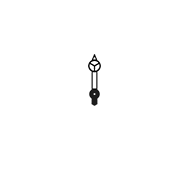


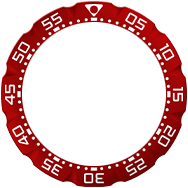

The company established by Edouard Heuer in 1860 would rely on two foundations – family leadership and technical innovation. These foundations served the company well, both in the early years and in the decades that would follow.

At age 20, Edouard Heuer opened his watch making shop in the family farm, at Saint-Imier, producing pocket watches, mostly in silver In 1864, he would move the company to Brugg, where it operated under the name Edouard Heuer & Compagnie. The third location came in 1867, when Edouard Heuer moved his company to the town of Bienne, in the canton of Bern. The company would remain in Bienne for well over 100 years.

In 1869, Edouard Heuer changed the course of watchmaking with his first patent, covering a crown-operated, keyless winding system. This new winding crown replaced the separate key that had been required to wind a watch, and proved to be a popular innovation. Edouard Heuer & Cie. continued to innovate in the areas of design, engineering and manufacturing, driven by his instincts as an entrepreneur and his strong vision of the future.

In the 1880s, sporting competitions rapidly expanded, and Edouard Heuer recognized that accurate pocket chronographs were important to these events. The company began to produce large quantities of pocket chronographs, which were used to time races on roads, cinder running tracks and over water. The chronograph, perhaps in a silver case, became a status symbol for enthusiasts of horse or greyhound racing, as well as other sportsmen.

In 1887, Heuer introduced a patent to improve the “oscillating pinion.” This improvement allowed the chronograph to start and stop instantly with the use of a push-button. By streamlining the movement design, the oscillating pinion simplified the chronograph’s assembly and maintenance. Edouard Heuer deemed this innovation “the perfected chronograph,” and it is still used to this day.

At the turn of the 20th century, innovations in industrial production, transportation, science and medicine brought demands for more precise timing. In athletics, demands for accurate, reliable timing gear became more critical, as competitors and world records might be separated by mere hundredths of a second.

While chronographs are essential in timing sports events and travel, a visit by Charles-Auguste Heuer to his physician led to an innovation in medical timing. The colorful scale on Heuer’s new Sphygmometer pocket chronograph, patented in 1908, allowed the physician to determine the patient’s pulse rate, after counting heart beats for only 20 seconds.

As travel by automobile and air took hold, Heuer designed a rugged instrument to be installed on the dashboards of the new generation of vehicles. The “Time of Trip” was a precision chronograph, indicating the time of day on the main dial, while two hands on a smaller dial recorded the duration of a journey. The driver or pilot used a pusher to start and stop this “time of trip” recorder, for example, to measure running time of a drive.

As wristwatches began to take the place of pocket watches, Heuer moved the precision chronograph from the pocket to the wrist. In 1914, the Heuer catalog described the wrist chronograph as something “unique on the market”.

Disciplines as varied as sports timing, industrial production and artillery calculations demanded more precise stopwatches. Charles-Auguste Heuer, the son of Edouard Heuer, was now head of the company, and he led a project to take stopwatches from 1/5 second to displays of 1/50 and 1/100 second, in the Mikrograph and Semikrograph. Split second versions soon followed, to show the time differential between two competitors.

The precision and reliability of Heuer’s stopwatches made them the choice for the world’s leading sporting events. Heuer was a supplier of chronographs for the Olympic Games, as well as world championships in alpine events. These events were precursors for numerous appointments for TAG Heuer to time motor sports, athletic and sailing events in the decades ahead, including the Indianapolis 500 and Formula One races.
1958 marked the dawn of a new era for Heuer. Jack Heuer became the fourth generation to manage the family company.
The decade would see new chronograph models, innovating designs for legendary stopwatches and dashboard timers dominating the rally world.

Jack Heuer formally joined Ed. Heuer & Co. S.A., as the fourth-generation leader of the family business. The company discontinued sales of conventional wristwatches and focused on wrist chronographs, stopwatches and dashboard timing instruments for use in races and rallies. Jack Heuer would lead his company into all forms of motorsports, from the amateur club racers to the Ferrari Formula One team.

In 1958, Heuer redesigned its dashboard timers to improve legibility and introduced innovative new models. The Rally Master pair (Master Time clock and Monte Carlo stopwatch) would dominate the rally world. The Super Autavia is Heuer’s first chronograph for the dashboard or pilot’s yoke, and the Sebring offers split second timing.

Stopwatches were the mainstay of Heuer’s business, and the company redesigned the line-up as the company approached its 100th anniversary. The Game Master was a stopwatch on a wrist strap, suited for referees. In 1960, Heuer celebrates its 100th anniversary by redesigning its line of stopwatches. The “Century” line incorporates central minute register and red / black colors to improve legibility, with a full line of stopwatches for athletics, motorsports and industrial timing.

On February 20, 1962, astronaut John Glenn became the first American to orbit the earth and the first man to wear a Swiss timepiece in space. A Heuer stopwatch strapped to his wrist timed his 4 hour, 56 minute flight. In July 1969, another Heuer stopwatch would time the descent of The Eagle to the surface of the moon. Both these Heuer stopwatches are on display in the Smithsonian Museum.
Historically, Heuer had identified most of its chronographs with only reference numbers, but in 1962 the company began using distinctive names for its models.
The Autavia was the tool for automobiles or aviation. The Heuer Carrera would follow in 1963, capturing the power of a beautiful name, the romance of racing and the purity of design.
1968 would bring the Camaro, using a cushion-shaped case to celebrate a popular muscle car of the era, and the Skipper, a colorful yachting watch.

The “Autavia” chronograph is Heuer’s first chronograph with a Collection name. Taking the name from the dashboard timers from the 1930s, the Autavia incorporates features for AUTomobiles and AVIAtion. Cases have a rotating bezel to track minutes or hours, to indicate speed on a tachymeter scale, or for the traveler to track a second time zone. Over the next two decades, Heuer would offer the Autavia in over 80 versions.

In 1963, Heuer introduced the Heuer Carrera, the chronograph that captured the romance and danger of racing. Jack Heuer took the name from the Carrera Panamericana road race, a border-to-border race staged in Mexico, from 1950 to 1954. The powerful angular lugs of the Heuer Carrera conveyed its strength, and dials were available with scales for tachymeter, decimal minutes or pulsometer. Suitable for the track, sport or dress, Heuer Carreras included triple calendar models and cases in steel or gold.
In 1964, Heuer acquired Leonidas, a leading maker of stopwatches and chronographs.
The Leonidas acquisition greatly expanded Heuer’s line of stopwatches.

In 1968, Heuer introduced the Camaro, with an entirely new cushion-shaped case, the brand’s first move away from traditional round cases. The Camaro was popular with racers, most models being offered with a tachymeter scale on the dial. Production continued into the early 1970s, with almost 50 models of the Camaro being offered, all of them with manual-winding movements. The cushion shape is to be considered as the forerunner of the square Monaco.

Heuer provided the timing equipment used by the yacht Intrepid, when it defended America’s Cup off Newport, Rhode Island. To celebrate the victory, in 1968, Heuer created a new chronograph, with colors matching the Intrepid. The dial displayed vivid blue, orange and green tones, with a 15-minute count-down recorder. Eight models of the Skipper would be offered over the next 15 years.

Through its sponsorship of Swiss Formula One hero Jo Siffert, Heuer became the first non-automotive logo to appear on a Formula One car. The engagement with Formula One would gain a higher profile two years later, when Heuer became a sponsor of the Ferrari Formula One team, with drivers Mario Andretti, Jacky Ickx, Niki Lauda, Clay Regazzoni and Gilles Villeneuve all wearing Heuer chronographs. Jack Heuer presented each of these drivers with an 18-karat gold Heuer Carrera.
Heuer introduced the world’s first automatic chronographs in 1969, with the Autavia, Heuer Carrera and Monaco models.
Heuer quickly moved from the classic black and white of the 1960s to the vibrant colors and outrageous shapes of the 1970s.

The joint venture led by Heuer would be the first to offer automatic chronographs in worldwide markets, with the Calibre 11 (Chronomatic) movement. The automatic Autavia, Heuer Carrera and Monaco were introduced in March 1969, at press conferences in Geneva and New York City. Beyond the technical innovation of the movement, new cases jumped from the look of prior decades into the radical style of the 1970s.

Three models were powered by Heuer’s first automatic movement, but it was the new Monaco that captured the world’s attention. The Monaco combined an edgy square case, with midnight blue or charcoal dials, to create a chronograph that would be noticed For the movie, Le Mans, Hollywood star Steve McQueen wanted to follow the style of his racing hero, Jo Siffert, who was an ambassador for Heuer. This led McQueen to select the Heuer Monaco chronograph for his wrist and the “Heuer Chronograph” patch for his racing suit. The bold combination brought worldwide attention to Heuer’s new chronograph. The final version of the Monaco (which today’s collectors call the “Dark Lord”) incorporated the military look of the 1970s, using a black dial in a black-coated case.
Following the launch of its first automatic chronographs, Heuer began to expand the model line-up with bold shapes and colours.
Toward the end of the decade, there was a move to elegance with sleek cases and refined lines.

Bold automatic chronographs introduced by Heuer included the Calculator, which incorporated a circular slide rule, and the massive Montreal, with dial choices in blue, white, black and champagne. The Silverstone celebrated the England’s Formula One circuit, with red, blue or fume (smoke) dials. Heuer experimented with monocoque cases, with fiberglass used for the very exotic looking Temporada model.

Heuer’s Electronics Division developed the Centigraph, a timing system used by Ferrari racing team. This system allows racing teams to keep track of their drivers, with great precision. Displaying times to 1/1000 second, the Centigraph allowed a team to time multiple cars, with the number of laps, the time of the last lap and total time, being printed out on the spot. Special features were added, with other racing teams soon becoming customers.

Heuer pioneered electronic timing for the world’s leading racing teams, and this same type of technology soon made its way into chronographs. The 1975 Chronosplit appeared as a friendly robot, with its dual displays for the time and chronograph functions. The Manhattan was far more radical, its six-sided case housing both analog and digital displays. These new chronographs faced huge challenges, however, from difficult exchange rates between the Swiss Franc and the U.S. Dollar and from newly-developed quartz watches from Japan.

After the excesses of the early 1970s, Heuer moved to more refined, elegant designs toward the end of the decade. The Cortina, Jarama, Monza and Verona celebrated European destinations for racing and other sports. The Daytona and Kentucky captured the excitement of racing venues in the United States, one for race cars and one for race horses. The models featured slimmer cases, many of them having integrated steel bracelets, designed for sport or elegant attire.

Heuer’s 1978 catalog was full of automatic and electronic chronographs, but in 1979 the company introduced the rugged dive watches that would become its future. Beginning with a handful of models, the dive watch catalog would be expanded to dozens of models, with automatic or quartz movements. Dials were orange, luminous, olive and pewter, or the traditional black, with sizes ranging from 28 to 42 millimeters.
Under the new ownership of Techniques d’Avant-Garde business group, TAG Heuer made the transition from a brand associated with mechanical chronographs to a company designing watches for the 21st century.
Models developed in the 1980s became the mainstays of today’s TAG Heuer catalog.
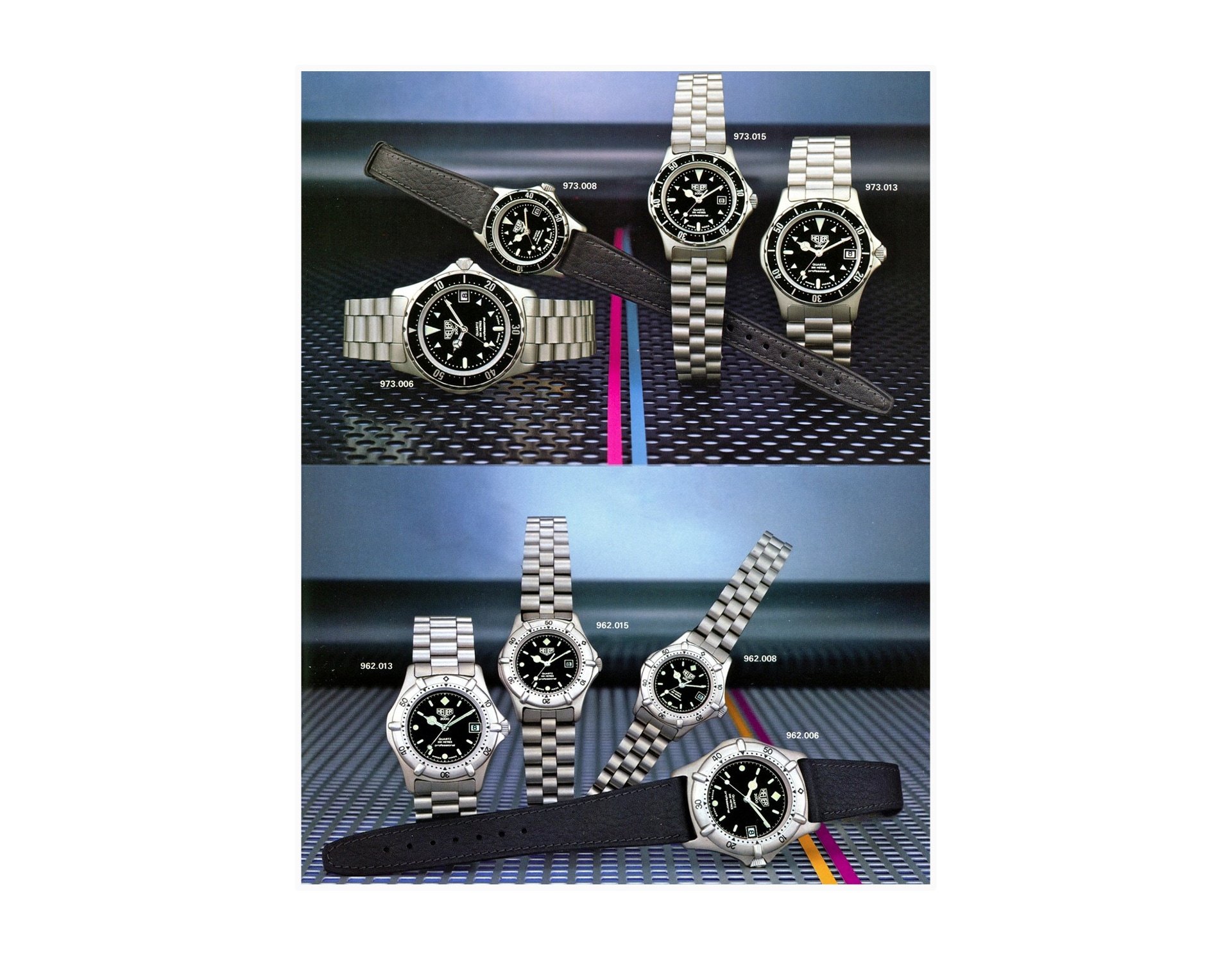
In the early 1980s, Heuer announced six unique functional features that would characterize its new series of dive watches. Four features are specifically identified with diving – 200 meter water resistance, a screw-down crown, a unidirectional bezel and a double clasp on the steel bracelet. Sapphire crystals and luminous markings ensured the utmost legibility. These features have been carried forward to today’s Aquaracer.
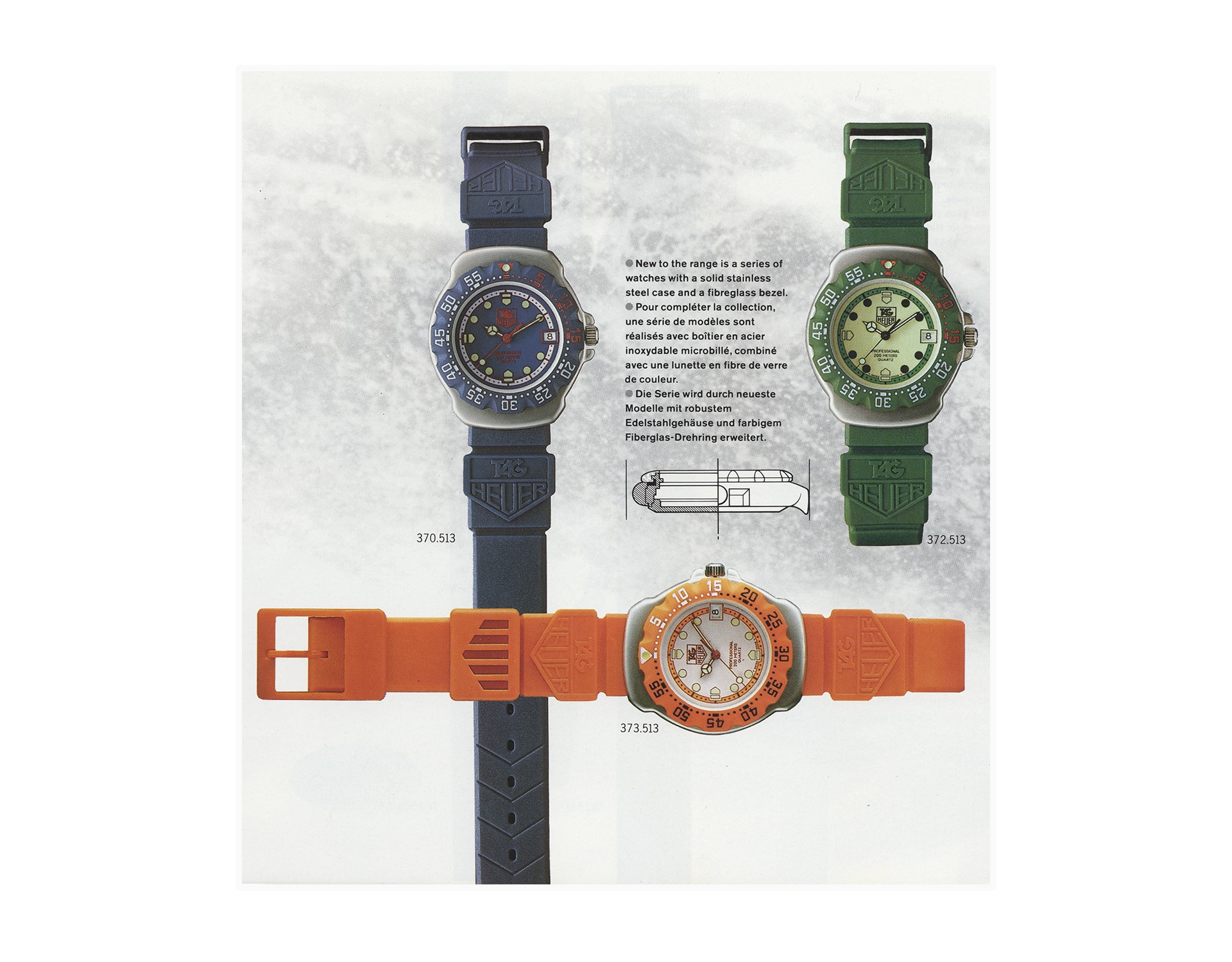
In 1983, TAG Heuer responded to the introduction of a new paradigm in the world of watches, with a revolutionary collection of its own: the TAG Heuer Formula 1. The TAG Heuer Formula 1 offered the same style of bright colors, plastic cases, simple quartz movements and fun packaging. True to its dive watch heritage, the TAG Heuer Formula 1 had 200-meter depth rating and bezel, marked in minutes.
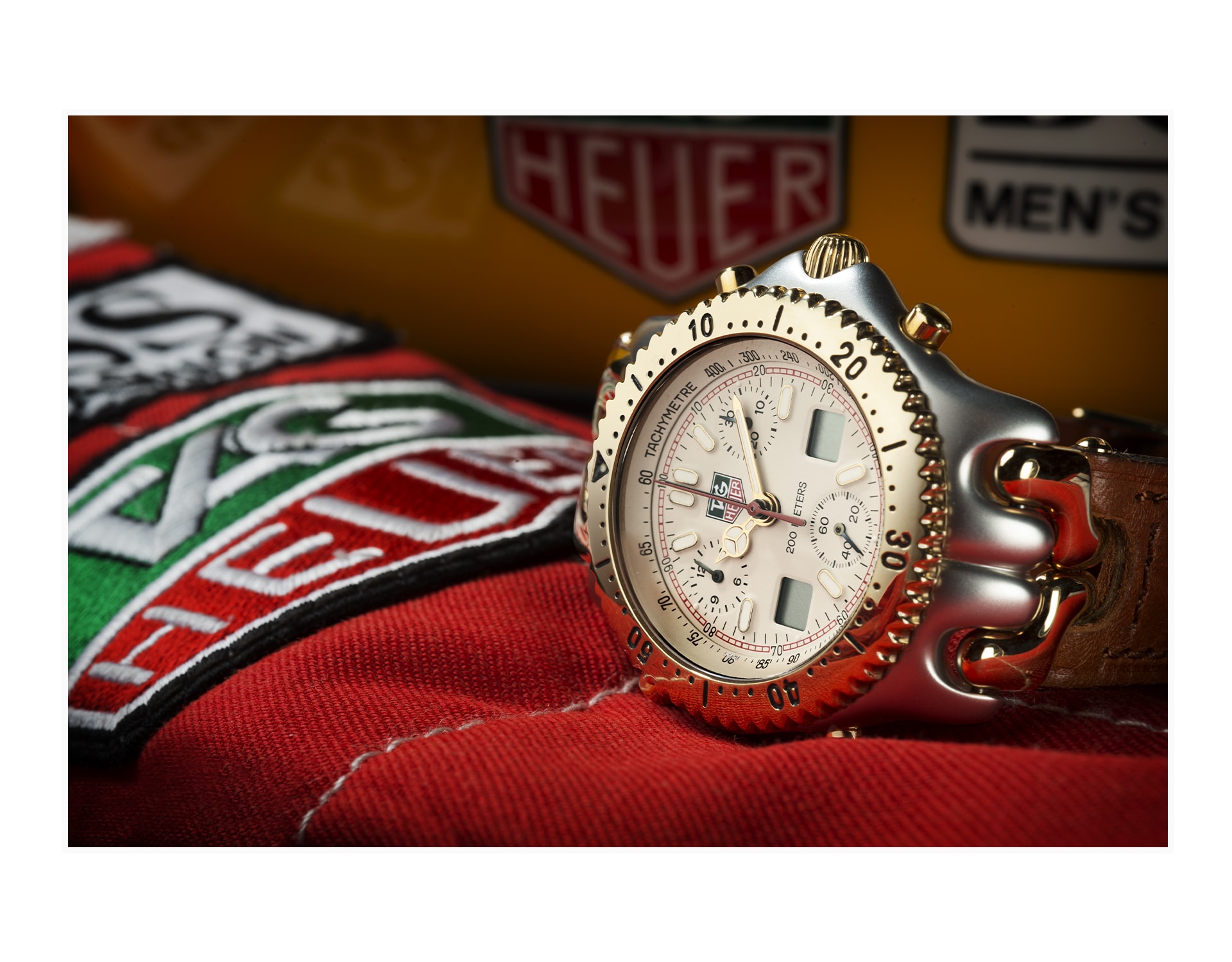
TAG Heuer soon moved upmarket, from its traditional dive watches to watches that would incorporate the most sophisticated designs. Sales materials emphasized that the new S/el watches could be worn with a diving suit or a dinner jacket. Formula One champion Ayrton Senna wore an S/el as his every-day watch, contributing with TAG Heuer on the design of its unique bracelet. The design of this watch was made by Eddy Schöpfer. The series was renamed the “Link” in 1999, a fitting tribute to this distinctive bracelet.
TAG Heuer supported its new portfolio of watches with award-winning advertising campaigns.
The 1991 to 1994 campaign “Don’t Crack Under Pressure” celebrated the determination and focus of the brand’s ambassadors, such as Michael Schumacher and Ayrton Senna.
From 1995 to 1997, TAG Heuer used the “Success. It’s a Mind Game.”Campaign, showing how top athletes and achievers push themselves to the limits.

Following the introduction of many new models in the 1980s, by the mid-1990s, TAG Heuer would reconnect with the brand’s classic chronographs from the 1960s. In 1996, TAG Heuer relaunched the TAG Heuer Carrera, following the style of the original 1964 model in almost every detail. The Monaco would be re-issued in 1998, with an all-black dial. The TAG Heuer Carrera and Monaco have remained vital models in the TAG Heuer catalog since these first re-issues.

In 1999, leading French luxury-goods group LVMH Moet Hennessy Louis Vuitton acquired TAG Heuer. Jack Heuer, who had been forced to sell the family business in 1982, returned to TAG Heuer in 2001, as the company’s Honorary Chairman. He would make appearances all around the world, sharing the heritage of the brand with a new generation of enthusiasts.
To open the 21st century, TAG Heuer would develop entirely new approaches to the construction of watches and their movements.
These innovations would provide record-breaking precision, in watches styled to reflect their leading-edge technologies.
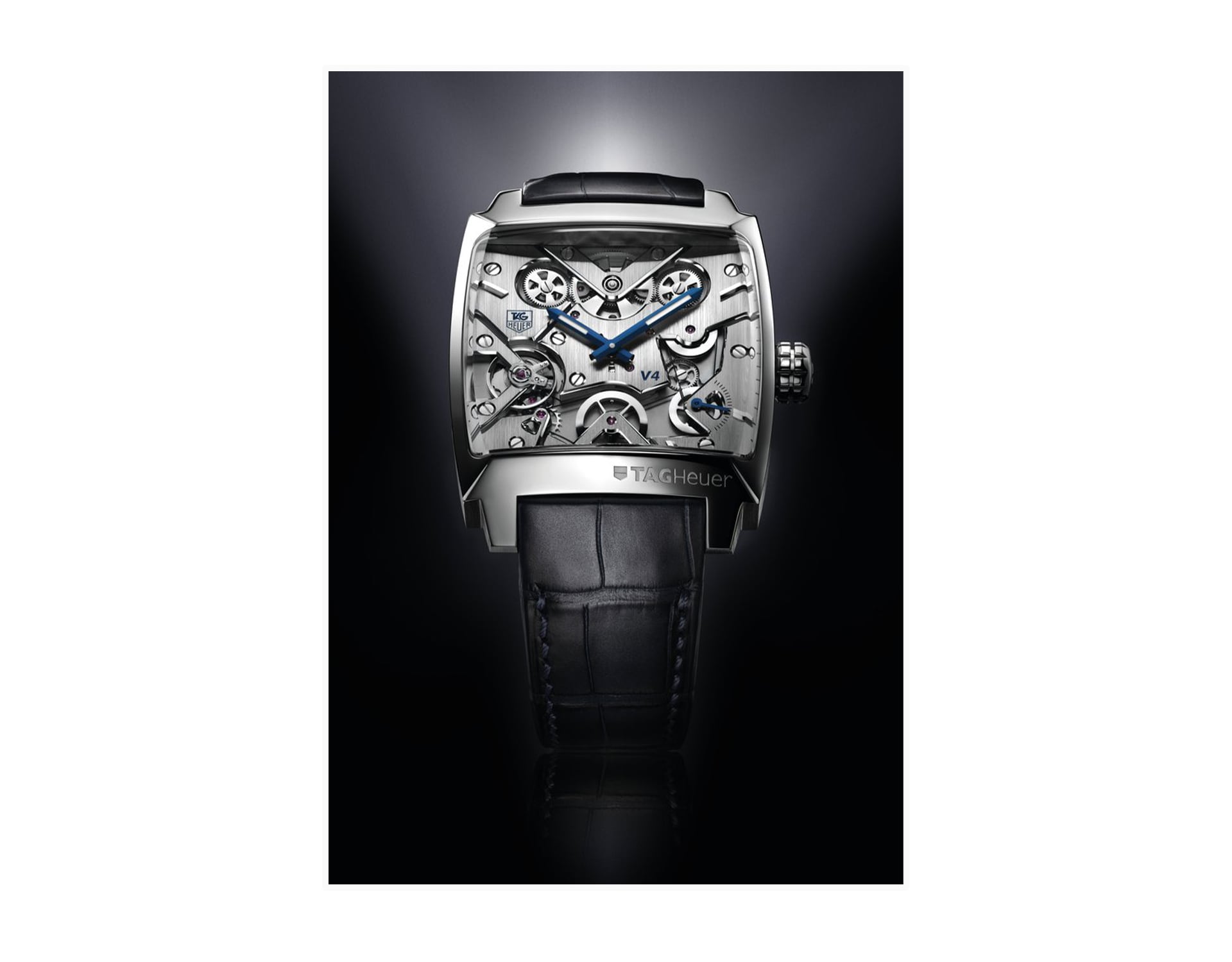
The Monaco V4 Concept Watch introduced an entirely new approach to powering a mechanical watch, with construction that evokes a racing engine. This radical watch used an ingot on rails to produce power, tiny belts to transfer this power, and four barrels that mimic the lay-out of an engine block. Cases for the Monaco V4 have included platinum, titanium, carbon matrix composite, and rose gold, and TAG Heuer marked the 10th anniversary of the model with a tourbillon option.

In 2004, TAG Heuer introduced the Aquaracer line of watches, with roots going back to Heuer’s first dive watches from the early 1980s. The first generation Aquaracers offered a 300 meter depth rating, while the next generation (introduced in 2009) increased this to 500 meters. The Aquaracers have used an enormous variety of materials, colors and movements, all designed to provide the diver with a highly-legible, reliable watch.

In 2010, TAG Heuer released its first in-house chronograph movement, the Calibre 1887. The Calibre 1887 is an integrated movement, featuring a column wheel and the same style of oscillating pinion that Heuer had patented in 1887. The Calibre 1887 movement powered a new generation of TAG Heuer Carrera chronographs, and would serve as the basis for the Heuer 01 in-house movement.

In the mid-2000s, TAG Heuer created a workshop that would develop and incorporate cutting edge technologies to produce a very limited number of innovative watches, all being handmade. The Mikrograph (2011) used an integrated movement to offer 1/100 second accuracy, with the central chronograph hand making a full revolution every second. The Mikrotimer Flying 1000 extended TAG Heuer’s ultra-high frequency line-up to 1/1,000 second accuracy, with the central chronograph second hand completing 10 rotations per second. The name was derived from the Heuer Microtimer, from 1966, an electronic timer that was the world’s first timer with 1/1,000 accuracy. The last of this series was the Mikrogirder, shown in 2012, which offered 5/10’000 second precision. The last of this series was the Mikrogirder, shown in 2012, which offered 5/10’000 second precision. TAG Heuer extended the Pendulum technology when it introduced the Mikropendulum Tourbillon, which offered 1/100 second accuracy and a tourbillon, while the MikropendulumS incorporated two magnetic Pendulums and a double tourbillon.
TAG Heuer leverages its rich portfolio of historic watches, by developing and incorporating today’s leading-edge technologies.
Whether the enthusiast prefers a silicon chip, a tourbillon or a carbon hairspring, their watch connects TAG Heuer’s past and future.

In November 2015, TAG Heuer introduced the first Swiss luxury smartwatch, the TAG Heuer Connected watch. Residing in a TAG Heuer Carrera-style case, the Connected watch incorporated newly-developed technology from partners Intel and Google. Purchasers would be able to exchange the Connected watch for a TAG Heuer Carrera with a traditional mechanical movement. The Connected Modular series (2017) allows the wearer to switch the smartwatch module to an automatic watch module, using the same strap and lugs.

In March 2017, the style of the new Autavia had been selected by enthusiasts, choosing between 16 classic Autavia models in the “Autavia Cup” competition. Limited Editions of the Autavia have marked Jack Heuer’s 85th birthday and paid tribute to Swiss Formula One hero Jo Siffert, while other models have used color schemes from the “Viceroy” and “Orange Boy” Autavias. In September 2017, TAG Heuer collaborated with its community of vintage collectors to present exhibitions in 10 cities around the world. There were over 400 watches on display, half from the TAG Heuer Museum and half from individual collectors. Each city had its own theme, ranging from cars and drivers, to military watches, to sailing and diving.
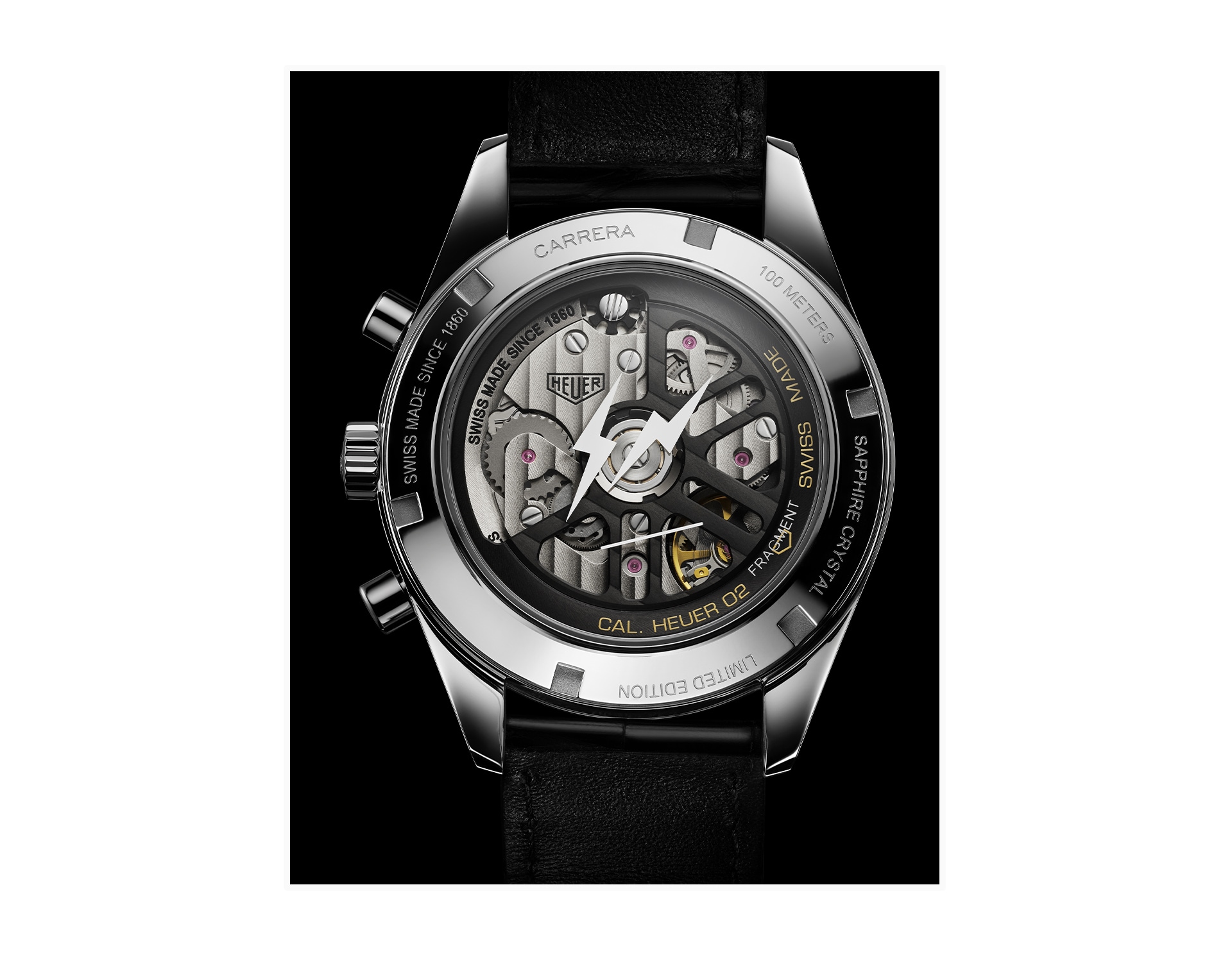
The limited-edition Fragment Design TAG Heuer Carrera marked the debut of the Heuer 02 in-house movement in a TAG Heuer Carrera case. This movement uses the 3-6-9 layout of Heuer’s classic 1960s chronographs, and delivers 80 hour power reserve. Designed by street wear legend Hiroshi Fujiwara, the Fragment Design TAG Heuer Carrera drew inspiration from a rare three-register TAG Heuer Carrera produced in 1968.
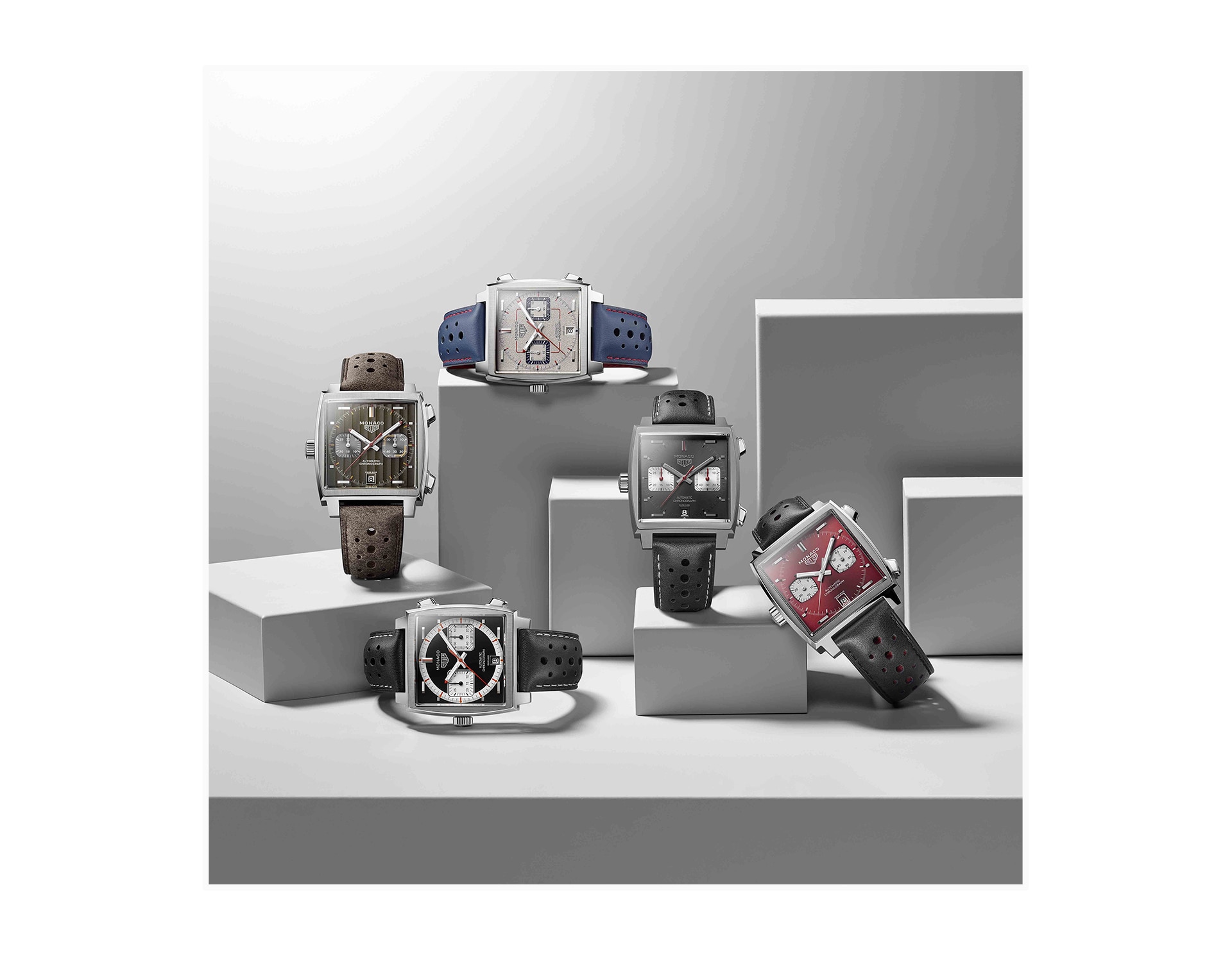
The mark the 50th anniversary of the Monaco, TAG Heuer offered a series of five limited edition models, each reflecting the style of a decade. There was Olive Green for the 1970s, Victory Red for the 1980s, Industrial Gray for the 1990s, Black and White for the 2000s, and Deep Gray for the 2010s.




